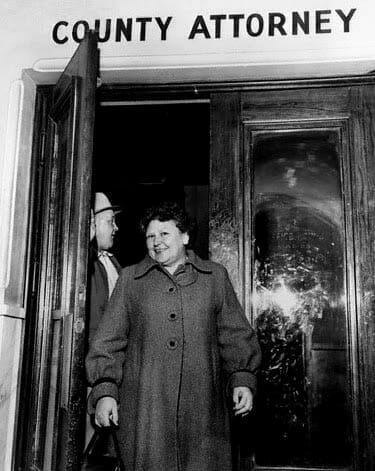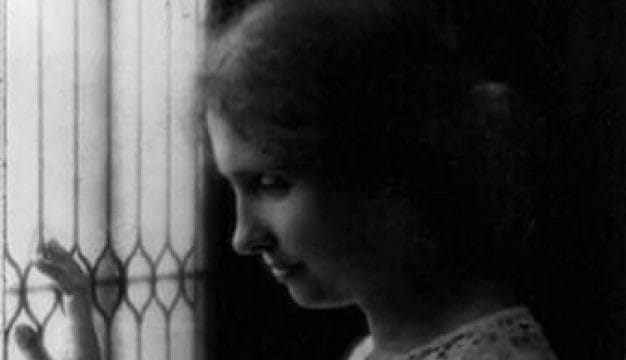Nannie Doss
 Nannie Doss
Gleeful serial killer Nancy “Nannie Doss” Hazle was known alternately as the Giggling Granny, the Giggling Nannie, the Jolly Black Widow, the Lonely Hearts Killer, Lady Bluebeard, and, as one newspaper dubbed her, the “self-made widow.” Arrested for the murder of one husband in 1955, she confessed to murdering four and maintained that she never harmed her “blood kin.” Various law enforcement officials in Alabama and elsewhere, however, speculate that she is likely to have murdered as many as 12 people, including a mother in law, a grandson, a granddaughter, her mother, her sister, and two of her own children with rat poison or arsenic.
Nannie Doss
Gleeful serial killer Nancy “Nannie Doss” Hazle was known alternately as the Giggling Granny, the Giggling Nannie, the Jolly Black Widow, the Lonely Hearts Killer, Lady Bluebeard, and, as one newspaper dubbed her, the “self-made widow.” Arrested for the murder of one husband in 1955, she confessed to murdering four and maintained that she never harmed her “blood kin.” Various law enforcement officials in Alabama and elsewhere, however, speculate that she is likely to have murdered as many as 12 people, including a mother in law, a grandson, a granddaughter, her mother, her sister, and two of her own children with rat poison or arsenic.
Born in 1905 in Blue Mountain, Calhoun County, a small town situated between Anniston and Jacksonville, Nannie was one of five children of Jim Hazle and Louisa “Lou” Holder Hazle. Nannie had an unhappy and difficult childhood. Jim Hazle (who may or may not have been Doss’s biological father) was abusive and demanding and kept Nannie and the other children away from school for long periods of time to perform household chores and work on the family farm. Her mother, however, was considered loving and gracious to Nannie and her three sisters. When she was seven, Nannie claimed to have suffered a head injury when a train in which she was riding slowed suddenly and she hit her head on a metal train seat in front of her; she later cited this injury as the source of her destructive future behavior. She was also reported to have been obsessed with romance magazines, particularly the “lonely hearts” columns. Her father, however, forbade his four daughters from wearing makeup or dress clothes. She spent the rest of her life, when not murdering relatives, searching for glamour and romance.
 Nannie Doss and Family
In 1921, Doss went to work at the Linen Thread Company in nearby Anniston, where she met Charles “Charley” Braggs at age 16. Braggs wooed Doss and met with the approval of her father. Nannie married Braggs within months and moved in with him and his mother, whose temperament matched her father’s; the couple would have four children in quick succession. The marriage had disintegrated drastically by 1927, and this period seems to mark the start of Doss’s murderous habits. That year, two of the children died mysteriously after eating breakfast; their deaths were attributed to food poisoning. After being warned anonymously not to eat any food his wife prepared, Braggs left with their oldest daughter, Melvina, leaving newborn Florine home with Nannie and his mother. He would earn the dubious distinction of being the only husband not to die at the hands of Nannie. They were divorced in 1928. Braggs returned with Melvina and a new love interest in late 1928, and Doss took her daughters and moved back in with her parents, working in a local cotton mill to support herself and her children.
Nannie Doss and Family
In 1921, Doss went to work at the Linen Thread Company in nearby Anniston, where she met Charles “Charley” Braggs at age 16. Braggs wooed Doss and met with the approval of her father. Nannie married Braggs within months and moved in with him and his mother, whose temperament matched her father’s; the couple would have four children in quick succession. The marriage had disintegrated drastically by 1927, and this period seems to mark the start of Doss’s murderous habits. That year, two of the children died mysteriously after eating breakfast; their deaths were attributed to food poisoning. After being warned anonymously not to eat any food his wife prepared, Braggs left with their oldest daughter, Melvina, leaving newborn Florine home with Nannie and his mother. He would earn the dubious distinction of being the only husband not to die at the hands of Nannie. They were divorced in 1928. Braggs returned with Melvina and a new love interest in late 1928, and Doss took her daughters and moved back in with her parents, working in a local cotton mill to support herself and her children.
Doss met her second husband, Jacksonville resident Frank Harrelson, through a “lonely hearts” newspaper column. He wooed her with poetry, and she responded with randy letters and a photo. They married in 1929, but the marriage soon became rocky, owing largely to Harrelson’s alcoholism and violent temper. It was during this period that Nannie most likely killed her own newborn granddaughter with a hairpin to the brain shortly after birth, according to accounts from family members who were in the hospital at the time. A few months later, Nannie likely killed her two-year-old grandson, Robert, when he was left in her care. He died suddenly of asphyxia, and several months after his death, Nannie collected on a $500 life insurance policy she had taken out on him.
The marriage to Frank lasted 16 years until one evening in 1945 when he came home drunk after a night of revelry with friends who had returned from service in World War II. He forced Nannie to have sexual intercourse, and the next day she poured rat poison into one of Frank’s hidden jars of moonshine, according to her testimony. He died on September 15, 1945, but it was assumed that he died of food poisoning or some other ailment.
Arlie Lanning of Lexington, North Carolina, would be Nannie’s next unfortunate victim, having also placed an ad in the local lonely-hearts columns. Rat poison again proved to be the method of choice, this time added to one of Arlie’s meals. His cause of death was listed as heart failure as he was a heavy drinker and there had been a flu virus in the area at the time. Thus, the death occurred under less than suspicious circumstances—Nannie appeared to residents of Lexington to be the perfect spouse—and no autopsy was performed. After his death in 1950, Nannie went to live with her sister Dovie, who also met her demise soon after Nannie’s arrival
Richard L. Morton and Samuel Doss would become husbands and her next victims. Both met Nannie through lonely-hearts correspondence. She married Morton in 1952 in Emporia, Kansas, and not long after, Morton began often venturing into town for long periods of time to be with other women. Meanwhile, Nannie’s time was consumed with her mother, who had come to live with the couple in January 1953 after the death of Nannie’s father. Within days of her arrival, Lou complained of severe stomach pains and died. Morton died three months later after drinking a thermos full of coffee that Nannie had spiked with arsenic.
Doss then boarded a bus to see her new suitor, Samuel Doss, in Tulsa, Oklahoma; they married in June 1953. Doss was neither abusive nor an alcoholic, but Nannie still found fault with him. He forbade magazines and television that were not enlightening or educational. Nannie left him for a short period in protest until he put her name on his bank account and took out two life insurance policies with her as beneficiary. Her first attempt to kill him with arsenic-laced prune cake failed, and he spent a month recovering in the hospital. When he returned home, she used her tried and true “arsenic in coffee” method, and Doss died soon afterward.
This final murder would prove her undoing. The physician who had treated Doss suspected foul play. He convinced Nannie to allow an autopsy by telling her that it would save lives in the future if he could determine what illness had caused the death of her husband. When he found enough arsenic in Doss’ body to kill a horse, he alerted the police, who arrested Nannie and charged her with murder. Under interrogation, and in return for being able to keep a romance magazine, Nannie confessed to killing her husbands. Exhumations of several bodies confirmed that they had died of rat poisoning or arsenic.
 Nannie Doss
The state of Oklahoma found her guilty of murder. The state justice departments of North Carolina, Kansas, and Alabama also charged her with murder, but she was never tried outside of Oklahoma. At 48 years old, Doss faced the electric chair and the distinction of perhaps becoming the first woman in Oklahoma history to be executed. Two years later, a judge declared her insane, thus sparing her the electric chair. The judge later explained that he did not want to set a “poor precedent” by executing a woman and especially not a person with mental disabilities. Upon receiving her life sentence in 1955, Doss appeared thrilled at the prospect of life in prison. And her habit of smiling and giggling as she discussed her crimes earned her the “giggling granny” nickname. She had confessed to killing her husbands and blamed it all on the head injury she had sustained as a child, which she claimed had given her headaches all her life.
Nannie Doss
The state of Oklahoma found her guilty of murder. The state justice departments of North Carolina, Kansas, and Alabama also charged her with murder, but she was never tried outside of Oklahoma. At 48 years old, Doss faced the electric chair and the distinction of perhaps becoming the first woman in Oklahoma history to be executed. Two years later, a judge declared her insane, thus sparing her the electric chair. The judge later explained that he did not want to set a “poor precedent” by executing a woman and especially not a person with mental disabilities. Upon receiving her life sentence in 1955, Doss appeared thrilled at the prospect of life in prison. And her habit of smiling and giggling as she discussed her crimes earned her the “giggling granny” nickname. She had confessed to killing her husbands and blamed it all on the head injury she had sustained as a child, which she claimed had given her headaches all her life.
After two years in prison, she came to lament the life sentence and wished instead that she had been put to death. She retained a cheerful disposition, however, and often made jokes about her case. Interviewed about her life in the McAlester prison in Tulsa, Doss complained that the only job she was allowed there was in the laundry, noting that her offers to work in the kitchen were politely declined. Doss died of leukemia on June 2, 1965, on the tenth anniversary of her incarceration, and was buried in Oak Hill Memorial Park in McAlester, Oklahoma.


